For the past year, COVID-19 cases have disrupted in-person activities and transactions in Oklahoma. While consumer spending in the state largely has held up since last summer—boosted by government stimulus payments and online spending—the number of Oklahomans going to retail and recreation establishments steadily drifted downward in the second half of 2020. As a result, employment in those sectors remained below pre-COVID levels. As widespread vaccinations began in early 2021 and the number of new COVID-19 cases decreased, these trends finally began to reverse. This edition of the Oklahoma Economist evaluates the relationships between COVID-19, consumer spending, mobility and employment.
COVID-19 Cases
Oklahoma’s first case of COVID-19 was diagnosed in early March 2020. Initially, the spread of the virus in Oklahoma lagged the rest of the country. However, over the summer and through the end of 2020, the share of new cases in the state rose rapidly, outpacing the national average (Chart 1). Through March 2021, over 437,000 Oklahomans have contracted COVID-19, roughly 11% of the state population; over 7,800 Oklahomans died in the past year due to the virus. In addition, the indirect consequences of the virus have been far-reaching. Many Oklahomans lost jobs, childcare, school, and in some cases, continue to face long-term health conditions. In early 2021, the number of new cases dropped sharply in conjunction with the increased availability of vaccinations, but remain above levels from a year ago.
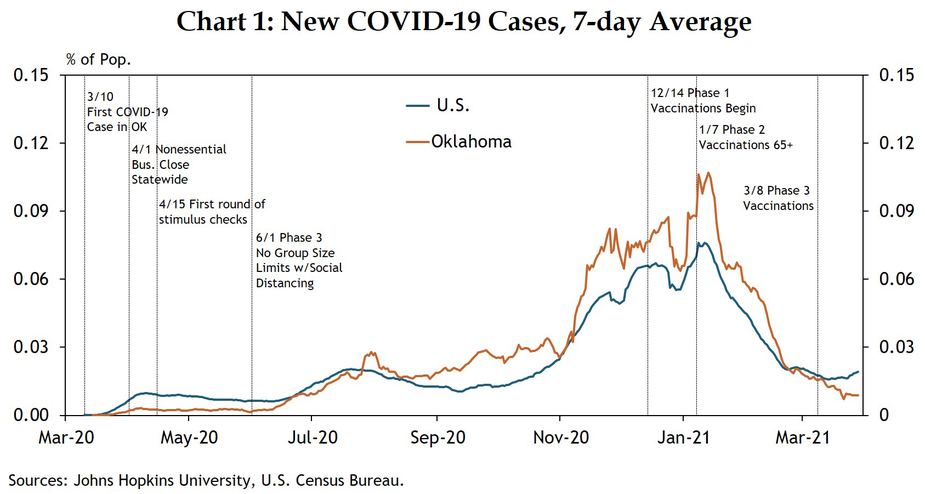
Consumer Spending
Despite the spread of the virus and its adverse effects on individuals, consumer spending in Oklahoma largely held up. Over the past year, while many households in Oklahoma lost income due to layoffs, pay cuts, or reduced hours, the federal government supported additional unemployment benefits to replace part of the lost income. Additionally, direct stimulus payments to individuals of $1,200 in April 2020, then $600 in December 2020, and another $1,400 in March 2021 boosted spending levels in the state. Total consumer spending was back near early 2020 levels during the second half of 2020, and above those levels by January and early February 2021 (in late February 2021, consumer spending dropped below summer levels due to extreme weather events but this drop is likely to be temporary) (Chart 2). While spending at restaurants and retail establishments plunged at the onset of the pandemic, many businesses quickly pivoted to online sales and to-go orders. Accommodation and food service spending in Oklahoma consistently has outperformed the rest of the U.S. throughout the pandemic, although it only returned to pre-COVID levels in recent months. While arts and entertainment spending has held up better in Oklahoma compared with the U.S. overall, it still is considerably lower than pre-pandemic levels. The arts, entertainment and recreation sector consists of primarily in-person activities and purchases, and thus has seen little improvement over the last nine months amid event cancellations and cautious consumers.
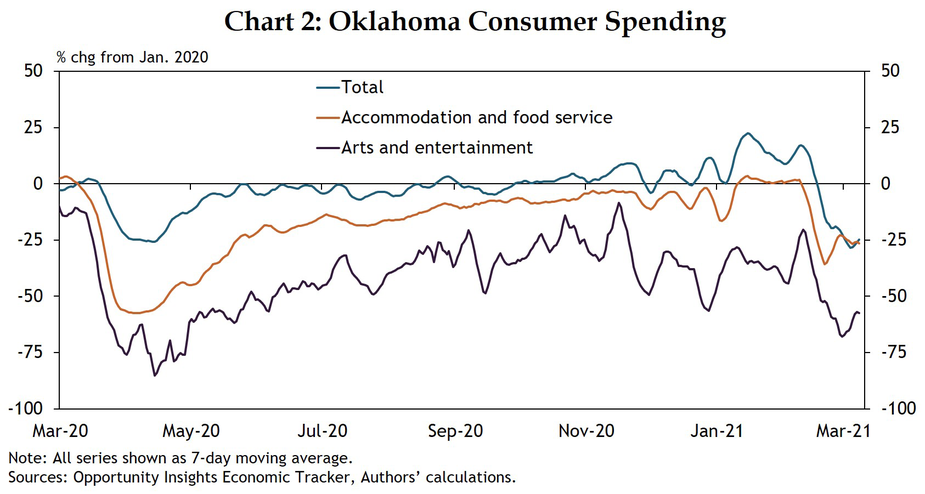
Mobility
At the onset of the COVID-19 pandemic, mobility was limited in high-populated areas to help contain the virus. While city and county governments instituted regulations limiting in-person gatherings and the share of customers allowed within dining establishments, many statewide restrictions on business activities were lifted June 1, 2020. Google mobility data from cell phone location services illustrate how the number of people visiting retail and recreation establishments fell steadily from July through early 2021, as new COVID cases rose (Chart 3). Then in February 2021, extreme weather events kept many Oklahomans at their place of residence. In fact, regional weather events had a greater impact on mobility to and from retail and recreation establishments than the “safe at home” government policies from April 2020. But the most recent data show that in-person retail and recreation visits had rebounded to above pre-COVID levels through March 26, 2021.
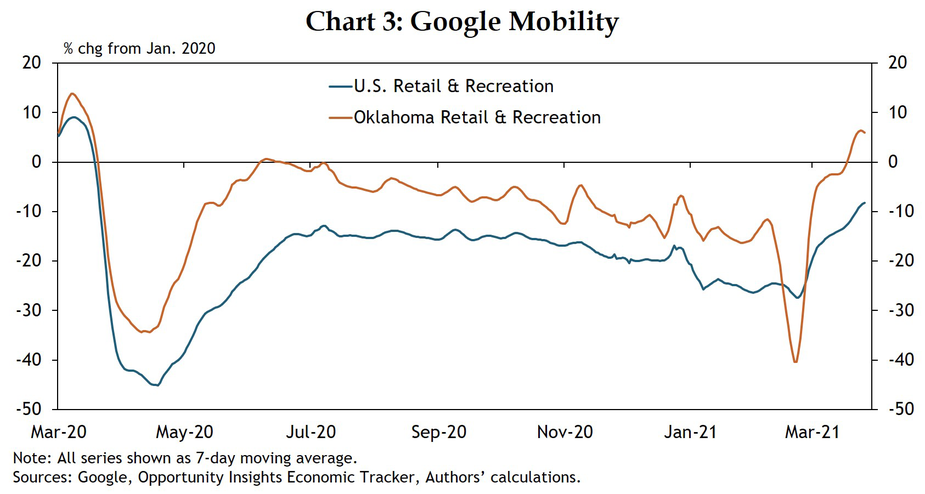
Employment
Oklahoma leisure and hospitality jobs dropped 34% from January to April 2020, while such jobs in the U.S. decreased 48% (Chart 4). Retail jobs fared slightly better from January to April 2020, but still decreased 10% and 15% in Oklahoma and the U.S., respectively. Since then, Oklahoma retail jobs have returned steadily, and at a steeper rate than the rest of the country. But as of February 2021, leisure and hospitality employment still was down 7% from a year ago in Oklahoma. U.S. employment in the industry still was 20% below year-ago levels. A full bounce back in employment for the leisure and hospitality sector likely will require increased mobility and foot traffic, which in turn will depend on the path of the virus and vaccinations.
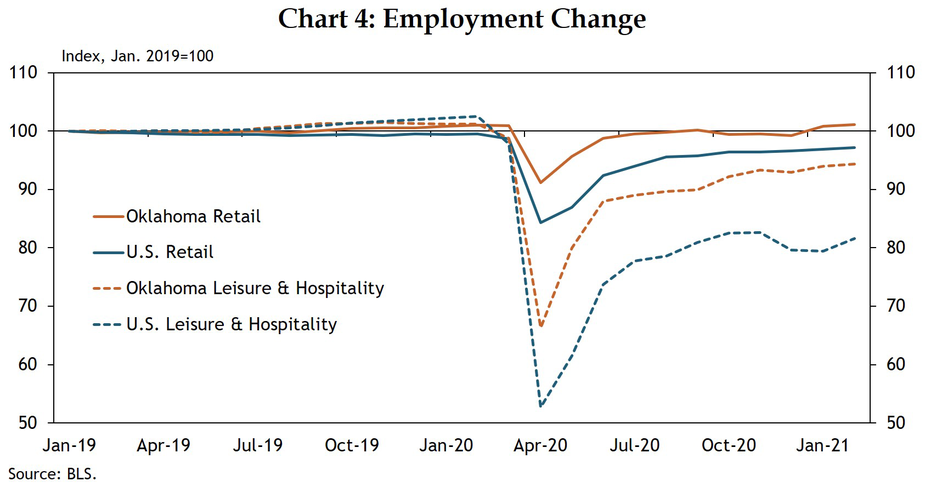
Vaccinations
The vaccination rollout in Oklahoma has progressed faster than the rest of the country. As of March 30, 2021, 30.5% of Oklahomans had received at least one vaccination dose and 17.4% were fully vaccinated (Chart 5). For Oklahomans over age 65, 73.5% have received at least one dose of the vaccine and over half were fully vaccinated._ Vaccination rates in Oklahoma have outpaced the U.S. by over 2% at times, but the rate of Oklahomans getting their second dose has slowed slightly compared with the rest of the county. Looking forward, fewer Oklahomans plan to get vaccinated. According to the Census Bureau’s Pulse survey ended March 15, 2021, 36.9% of Oklahomans indicated they had not been vaccinated but definitely will once it’s available, considerably less than the average of 51.4% in the U.S. overall._ Additionally, CDC External Linkcase forecasting for Oklahoma still indicates over 2,000 new cases per week with more deaths expected each week. These numbers could vary but likely will remain well above zero until herd immunity is reached.
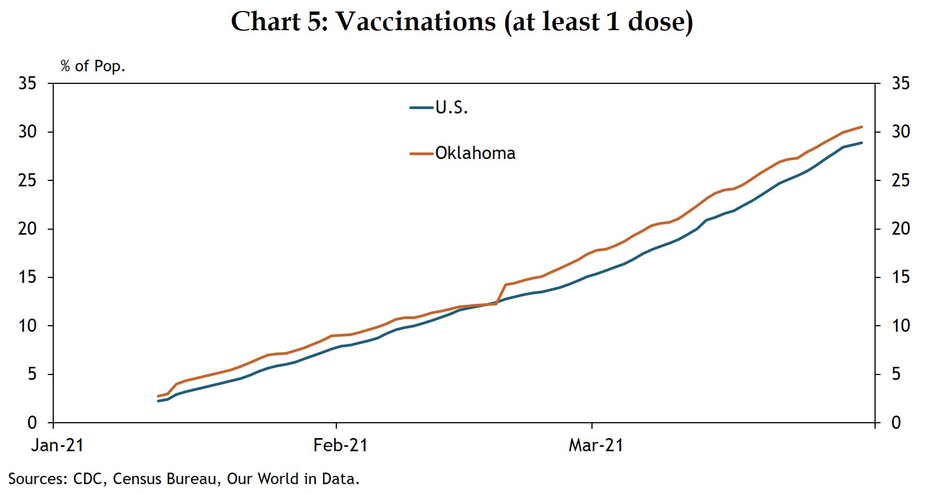
Summary
The onset of the COVID pandemic had a significant negative effect last spring on Oklahoma consumer spending, mobility and employment. While consumer spending rebounded relatively quickly as government stimulus programs were put in place and as consumers shifted to online purchases, mobility and employment in the sector—especially in leisure and hospitality—remained below pre-COVID levels as new cases surged during the second half of 2020. Since the vaccination roll-out of early 2021, new cases have dropped and mobility and employment have trended upward again. However, full recovery in the sector is unlikely until people begin moving around more. The share of Oklahomans receiving COVID vaccines so far has outpaced the nation, and the path of the virus and vaccinations likely will be a key determinant in the pace at which jobs recover in the state.
